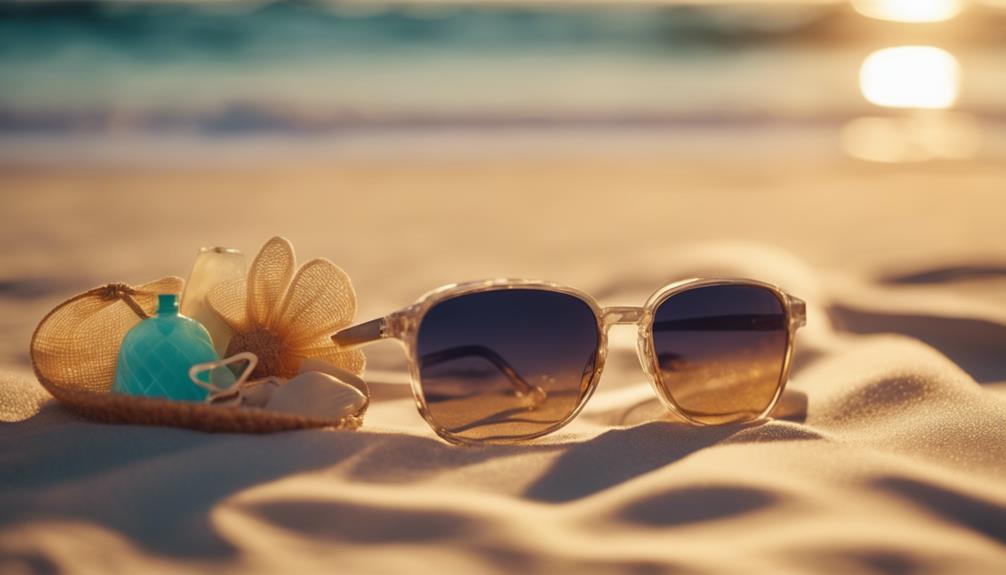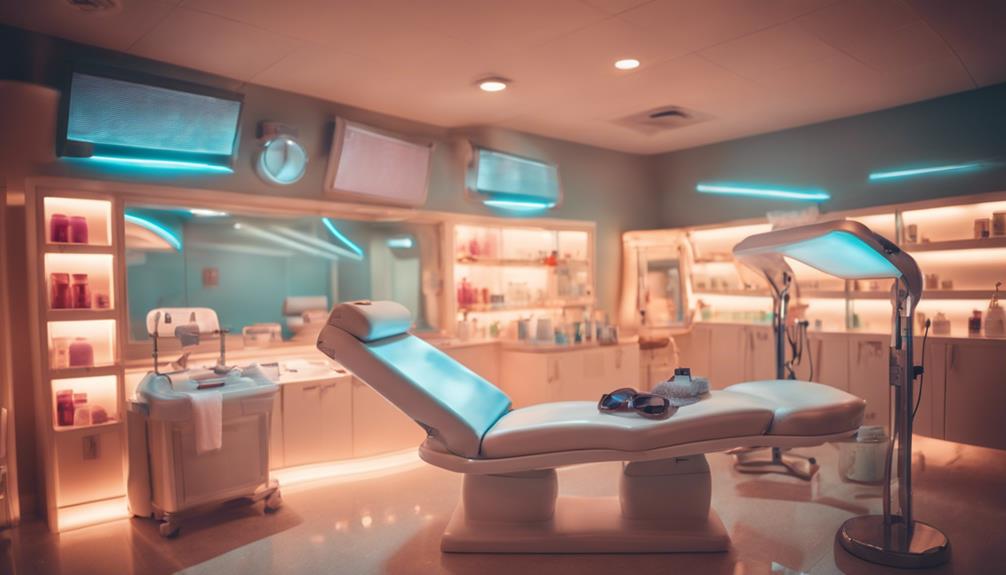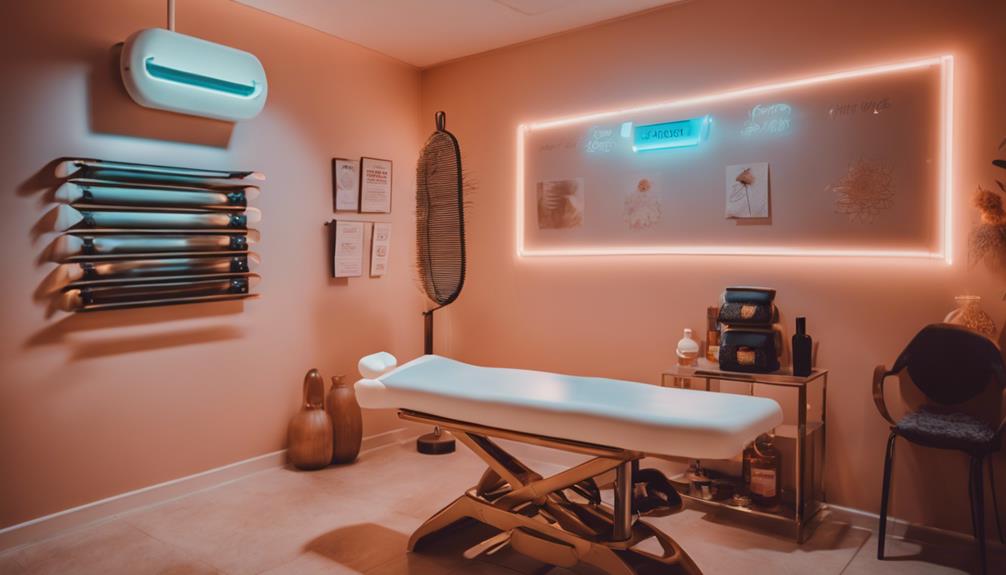You can totally rock a flawless tan without sun exposure—it's easier than you think! Start by exfoliating your skin, so you've got an even canvas to work with. Then, choose a high-quality self-tanner like NKD SKN or St. Tropez that smells good and has hydrating ingredients. When you apply it, use circular motions and pay attention to tricky spots like elbows and knees. Also, don't forget your tanning mitt for a smooth finish! Keep your skin moisturized daily, and you'll keep that glow going strong. Stick around to discover even more tips for achieving that perfect sunless tan!
Key Takeaways
- Exfoliate your skin thoroughly before applying self-tanner for an even and smooth canvas.
- Choose high-quality self-tanners with hydrating ingredients for a natural glow.
- Use a tanning mitt and apply in circular motions for seamless blending.
- Moisturize daily to maintain your tan and prevent dryness.
Preparation for Tanning
To achieve a flawless tan, start by thoroughly exfoliating your skin to remove dead cells and create an even canvas for self-tanner. Trust me, you don't want to look like a patchy leopard!
Use a gentle scrub in circular motions, focusing on those dry areas like elbows and knees. Hydrated skin is your best friend, helping the tanner apply smoothly and last longer.
After exfoliation, grab a lightweight moisturizer—it's like a drink of water for your skin! Just make sure it's oil-free to avoid any slippery mishaps.
Once your skin's prepped and primed, you're all set to embrace that sun-kissed glow. Remember, a little prep goes a long way in making your tan look natural and fabulous!
Choosing Quality Self-Tanners

After prepping your skin, it's time to choose a self-tanner that delivers a natural-looking glow without the sun's harmful rays.
You'll want to pick high-quality brands like NKD SKN or St. Tropez, which not only give you that sun-kissed look but also help avoid those funky smells! Trust me, nobody wants to smell like a walking carrot.
When selecting a self-tanner, check the ingredients—look for ones that hydrate your skin and are easy to apply. A good self-tanner should blend seamlessly for a flawless finish.
Effective Application Techniques

Achieving a flawless tan hinges on mastering effective application techniques that guarantee even coverage and prevent streaks.
Start by using gentle, circular motions when applying your self-tanner; this helps blend the product seamlessly into your skin.
Don't rush—patience is key! Allow the tanner to dry completely before dressing, or you might end up with unwanted smudges, and nobody wants that.
Focus on tricky areas like elbows and knees, as they can absorb more product and create uneven spots.
If you're aiming for a deeper color, try layering the tanner gradually, allowing each layer to dry.
Essential Tanning Tools

Having the right tools can make all the difference when it comes to achieving a flawless tan.
First up, a good tanning mitt is your best buddy! It helps you apply self-tanner smoothly and evenly, so you won't end up looking like a patchy pumpkin.
Next, consider a quality exfoliating scrub; it preps your skin by removing dead cells, ensuring a more natural glow.
Don't forget a lightweight moisturizer—applying it beforehand can keep your skin hydrated and help avoid those pesky streaks.
Finally, grab some barrier cream for your hands and feet; those areas can easily turn orange!
With these essential tools in your tanning arsenal, you'll be well on your way to a sun-kissed look without the sun!
Maintaining Your Tan

To keep your tan looking fresh and vibrant, daily moisturizing is key to locking in color and preventing dryness. It's like giving your skin a rejuvenating drink!
Here's how to maintain that gorgeous glow:
- Moisturize Daily: Use a rich, hydrating lotion to keep your skin soft and your tan even, because nobody loves dry patches!
- Gentle Exfoliation: Lightly exfoliate once a week to remove dead skin cells, keeping your tan looking smooth and natural.
- Limit Water Exposure: Try to avoid long baths or excessive swimming; your tan will thank you for it, and you'll keep that sun-kissed look longer!
Importance of UV Protection

Protecting your skin from harmful UV rays is essential, even when sporting a faux tan. You might think, 'I've got my self-tanner, so I'm safe!' but that's not quite true. Sun exposure can still cause damage, leading to premature aging or worse.
So, grab that sunscreen with SPF 30 or higher and slather it on generously. Don't forget those often-missed spots, like your ears and feet!
Try to stay out of the sun during peak hours, and rock a stylish wide-brimmed hat and some cool sunglasses. Your skin will thank you, and you'll keep that glow looking fresh and fabulous.
Tips for Faster Tanning

If you want to achieve a faster tan, staying well-hydrated and regularly exfoliating your skin are essential steps that can greatly enhance the bronzing process.
Here are three quick tips to speed things up:
- Drink Plenty of Water: Hydration keeps your skin looking plump and helps the self-tanner absorb better, giving you that dreamy glow.
- Exfoliate Regularly: A gentle scrub will remove dead skin cells, ensuring your tan goes on evenly and lasts longer. Plus, who doesn't love soft skin?
- Use Tanning Accelerators: These magical potions can help you develop a lovely tan faster, so you can show off those sun-kissed vibes in no time!
Follow these tips, and you'll be rocking that flawless tan before you know it!
Frequently Asked Questions
Can I Use Self-Tanner on My Face?
Yes, you can use self-tanner on your face! Just choose a product specifically designed for facial use, exfoliate beforehand, and apply with a tanning mitt for an even, natural-looking glow. Always moisturize!
How Often Should I Reapply Self-Tanner?
You should reapply self-tanner every 5 to 10 days, depending on your desired shade and skin type. Regularly moisturizing and gently exfoliating will help maintain an even, long-lasting glow between applications.
Can Self-Tanner Cause Skin Irritation?
Yes, self-tanner can cause skin irritation, especially if you have sensitive skin or allergies. Always patch-test new products before full application, and make certain your skin is clean and moisturized to minimize potential reactions.
What to Do if I Get Streaks?
If you get streaks, don't panic! Gently exfoliate the affected area, then apply a moisturizer to blend colors. For future applications, make certain of even coverage and use a mitt for streak-free results.
Are There Vegan Self-Tanning Options Available?
Yes, there are vegan self-tanning options available! Look for brands that use plant-based ingredients, avoiding animal-derived components. Check labels carefully, and you'll find great products that give you a beautiful, bronzed glow.
Conclusion
Now that you've got the scoop on achieving a flawless tan without the sun, it's time to shine like a star!
With the right prep, quality products, and a dash of practice, you'll be flaunting that sun-kissed glow in no time.
Remember, self-tanning is like making a cake; it's all about the right ingredients and technique!
So, grab your tools, follow these tips, and enjoy your beautiful tan while keeping your skin safe and happy!









